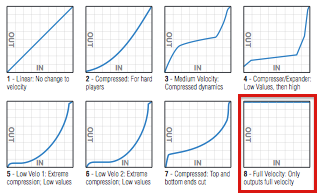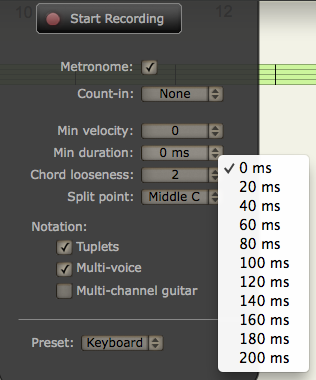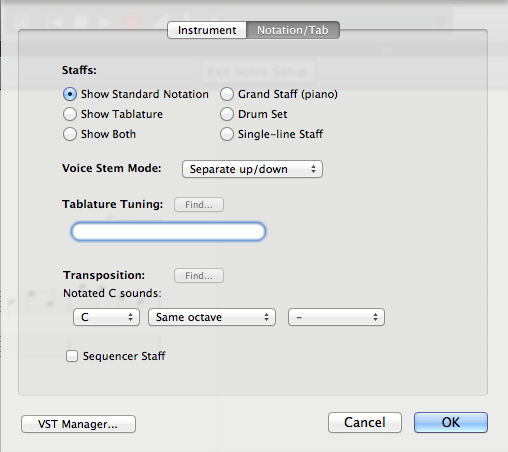broozar wrote: . . . 0ms does help though.
The other parameters affect accuracy and precision, as well, so the best strategy is to do a bit of experimenting to discover which set of parameter values works best for (a) the way you have your E-MU Xboard 49 MIDI keyboard configured and (b) the way you play . . .
Most of the time I use a Behringer UMA25S mini-MIDI keyboard, and it has a fixed velocity setting that maps to ON or OFF with no intermediate values, and this works best for me, since my primary instruments are electric bass and electric guitar, where setting the mini-MIDI keyboard to fixed velocity avoids having to deal with how soft or hard I press the keys . . .
I checked the E-MU website, and it appears that these are the velocity configurations for the E-MU Xboard 49, in which cased "8" is the option that maps to full velocity for all output . . .

The way the velocity is configured for the MIDI keyboard affects the accuracy and precision of MIDI recording in NOTION 4, so it is yet another factor to consider . . .
On a related note, MidiKit is a very nice MIDI File Editor for the Mac, and it shows the various MIDI messages, commands, notes, and so forth when you export the MIDI for a NOTION 4 score; and you can edit the MIDI parameters . . .
MidiKit (Mixage Software)I use MidiSpy (Codelle) for monitoring MIDI messages in real-time, and it is available at the Mac App Store, as is MidiKit, and both of these applications are priced reasonably, where MidiKit is approximately $12 (US) and MidiSpy is approximately $5 (US) . . .
I recall a discussion about MIDI velocity, and I think there might be a way to clear or to set the velocity for a group or series of notes, but this is not something I do, and it is all I recall at present . . .
My strategy for playing keyboards is vastly unusual, and it is started as an experiment several decades ago with the goal of determining whether it was possible to discover how to play grand piano without actually playing a grand piano (instead simply thinking about it in a highly focused way, mostly while sleeping) . . .
I made some initial progress, but it was slow until I got a drumkit and realized that grand piano keys are like tiny drums, cymbals, and Latin percussion instruments, at which time I had an epiphany, which specifically is that it is possible to play a grand piano as if it were a tiny drumkit with rectangular drums, cymbals, and Latin percussion instruments . . .
The other significant epiphany is that if you play enough notes very rapidly, at least a few of them will sound good, which then makes the other notes sound good, because instead of being primary notes, they are transition notes . . .
Yet another important bit of information is that there are 12 notes and approximately 10 octaves; and this makes it easier to keep track of everything, since the octaves are just higher or lower, hence you really only need to keep track of 12 things for Western music in equal temperament . . .
When these epiphanies, observations, and rules are combined, it makes it possible to skip a lot of otherwise traditional grand piano training and to go directly to what I call "texture playing", which is something I discovered on electric bass and lead guitar, where this is the only practical way to play very rapidly when composing stuff in real-time on the fly . . .
It requires rewiring the brain to create a new set of neural pathways between the auditory cortex and the frontal eye fields region of the brain, which is bounded by Brodmann areas 4, 6, and 8--which curiously is the area at the top of the head and makes the colloquial expression "played off the top of the head" surprisingly accurate--where this bit of rewiring is part of learning how to play an instrument without actually playing the instrument, where the "texture playing" aspect transcends key signatures and all that stuff; and it also allows playing "in between" notes on electric bass and lead guitar, although not on grand piano, but it can be done on a keyboard synthesizer with a preset that includes a bit of
automagical note-bending . . .
This is an example of this style of grand piano, which a bit of grand piano that I composed and played on a KORG Triton Music Workstation (88-Keys) for a song I was developing in 2009, and everything was composed and played in real-time on the fly on the first take . . .
[
NOTE: This was done before I switched to doing nearly everything with music notation and virtual instruments in NOTION 4, and the grand piano is only one part, but it is run through cascading echo units, hence sounds like more than one grand piano . . . ]
"Starlight" (The Surf Whammys) ~ Grand Piano, Electric Bass, Kick Drum ~ Remixed January 26, 2014 ~ YouTube music videobroozar wrote:i have set the velocity curve to very compressed and "Velocity Sense Time Limit Low" to 1, which makes it very hard to produce loud notes. however it does not get rid of the 2 initial problems: velocity cannot be completely disabled, and the notion's default playback is still based on what i entered, not the length & dynamic values of the notes in the score.
There is no direct one-to-one mapping of MIDI to music notation, so the best strategy is to do some experiments to determine how everything works, which includes developing a system for modifying or correctly notes that did not convert to music notation in such an optimal way . . .
broozar wrote: . . . how would you go about adding like 100 bars between 2 in the middle of the piece?
The only practical way to insert bars anywhere other than at the end of a score is to use the NOTION 4 Palette, where you select the bar tool and then use the mouse to create new bar lines, which in the example you provided maps to clicking the mouse 100 times . . .

Deleting measures works the same way, and while it is not the most elegant way to do it, this is not so difficult to do if you have a mouse . . .
Lots of FUN! 



